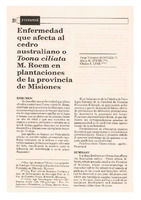Enfermedad que afecta al cedro australiano o Toona ciliata M. Roem en plantaciones de la provincia de Misiones
Date
1992-07-01Author
Vizcarra Sánchez, Jorge
Stehr, Alicia Mónica
Lori, Gladys Albina
Metadata
Show full item recordAbstract
Se describe una enfermedad que afecta al cedro australiano Toona ciliata M. Roem, cultivado en la provincia de Misiones, cuya sintomatología se caracteriza por la presencia de engrosamientos o agallas en el fuste y ramas, que se observan en plantas desde un año de edad y que son variables en cuanto a número, ubicación y tamaño en el árbol; dichas agallas alcanzan su máximo desarrollo y diámetro en ejemplares mayores de 10 años.
Las agallas se forman por hiperplasia celular en sentido radial, provocando rajaduras verticales en la corteza y una coloración castaña violácea en la parte afectada del leño, inutilizando la madera para la industria del debobinado y corte plano (faqueado).
En el laboratorio de la Cátedra de Patología Forestal de la Facultad de Ciencias Forestales Eldorado, se practicaron aislamientos a partir de material leñoso afectado proveniente de diferentes plantaciones. Se determinó la presencia del hongo: Fusarium decemcellulare Brick, al que mediante las correspondientes pruebas de patogenicidad se lo confirmó como agente causal de la enfermedad.
Paralelamente se efectuaron ensayos de control que consistieron en tratamientos quimioterápicos. Hasta el presente debido al carácter preliminar de los mismos no se pudo confirmar su efectividad. It is described here an illness that affects the Australian cedars - Toona ciliata M. Roem, which are cultivated in the Province of Misiones, whose symptomatology is characterized by the presence of tumors or gallnuts in the trunk and branches, which can be observed in one year old plants and which are variable in number location and size in the tree; these gallnuts reach their maximum development and diameter in specimens older than 10 years.
The gallnuts are formed by a cellular hypertrophy in a radial sense, causing ver- tical craks in the bark and a hazel violaceous coloration in the affected part of the timber, spoiling it for the industry of peeling and veneering.
The following experiment was conducted by the Laboratories of Forestal Pathological Department based at the University of Forestal Sciences in Eldorado.
Infected wooden material from various stands were isolated an evidenced the presence of Fusarium decemcellulare Brick, a fungui which through our pathogenical test was informed to be the very agent of the disease under scruting.
Moreover chemiatherapeutical control — tests run have been unable to evidence its effectiveness mainly due to the fact that tests runs to date are still in a preliminary stage.
Collections
- Revista Yvyraretá [342]
The following license files are associated with this item:




